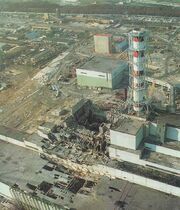Meltdown in Chernobyl is the 7th episode of Seconds from Disaster and tries to understand how did a test turned horribly wrong.
Plot[]
An usual night test producs a meltdown at the Chernobyl Nuclear Power Plant and kills 56 people while the health of thousands more continue to be affected.
Cause[]
There were two official explanations of the accident: the first, later acknowledged to be erroneous, was published

The aftermath of the disaster
in August 1986 and effectively placed the blame on the power plant operators. To investigate the causes of the accident the IAEA created a group known as the International Nuclear Safety Advisory Group (INSAG), which in its report of 1986, INSAG-1, on the whole also supported this view, based on the data provided by the Soviets and the oral statements of specialists. In this view, the catastrophic accident was caused by gross violations of operating rules and regulations. "During preparation and testing of the turbine generator under run-down conditions using the auxiliary load, personnel disconnected a series of technical protection systems and breached the most important operational safety provisions for conducting a technical exercise.The operator error was probably due to their lack of knowledge of nuclear reactor physics and engineering, as well as lack of experience and training. According to these allegations, at the time of the accident the reactor was being operated with many key safety systems turned off, most notably the Emergency Core Cooling System (ECCS), LAR (Local Automatic control system), and AZ (emergency power reduction system). Personnel had an

Prypiat after the disaster
insufficiently detailed understanding of technical procedures involved with the nuclear reactor, and knowingly ignored regulations to speed test completion. The developers of the reactor plant considered this combination of events to be impossible and therefore did not allow for the creation of emergency protection systems capable of preventing the combination of events that led to the crisis, namely the intentional disabling of emergency protection equipment plus the violation of operating procedures. Thus the primary cause of the accident was the extremely improbable combination of rule infringement plus the operational routine allowed by the power station staff.In this analysis of the causes of the accident, deficiencies in the reactor design and in the operating regulations that made the accident possible were set aside and mentioned only casually. Serious critical observations

Chernobyl today
covered only general questions and did not address the specific reasons for the accident. The following general picture arose from these observations. Several procedural irregularities also helped to make the accident possible. One was insufficient communication between the safety officers and the operators in charge of the experiment being run that night. The reactor operators disabled safety systems down to the generators, which the test was really about. The main process computer, SKALA, was running in such a way that the main control computer could not shut down the reactor or even reduce power. Normally the reactor would have started to insert all of the control rods. The computer would have also started the "Emergency Core Protection System" that introduces 24 control rods into the active zone within 2.5 seconds, which is still slow by 1986 standards. All control was transferred from the process computer to the human operators.
This view is reflected in numerous publications and also artistic works on the theme of the Chernobyl accident that appeared immediately after the accident, and for a long time remained dominant in the public consciousness and in popular publications.
